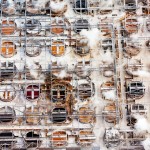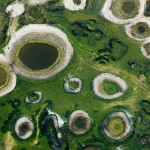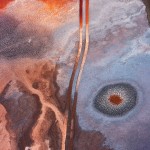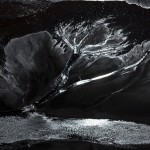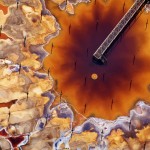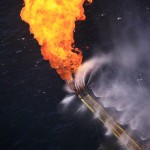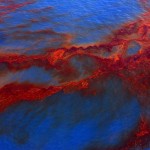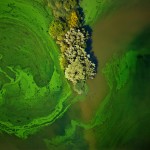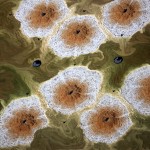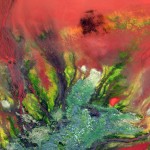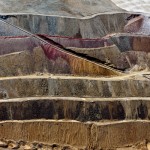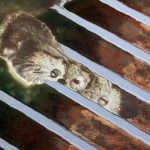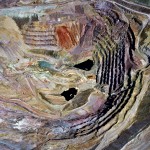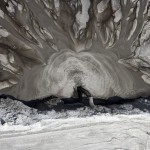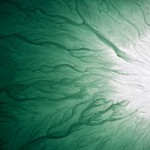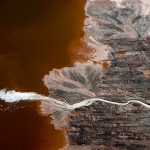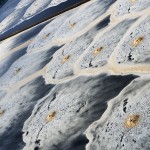Project Description
Biography
Photographer J Henry Fair is best known for his Industrial Scars series, in which he researches our world’s most egregious environmental disasters and creates images that are simultaneously stunning and horrifying, and more closely resemble abstract paintings by Georgia O’Keeffe and Jackson Pollock than what the collective views as reality. Mr. Fair’s work has been featured in segments on The TODAY Show, CNN, NPR’s Marketplace, and WDR German TV, as well as in most major publications, including The New York Times, National Geographic, Vanity Fair, Rolling Stone, New York Magazine, Harper’s Magazine, Smithsonian Magazine, and Scientific American. Additionally, Mr. Fair’s work travels around the world in fine art exhibitions at major museums, galleries, and educational institutions.
Mr. Fair has served as Artist-in-Residence at some of the nation’s top educational institutions for art and environmental studies, including Colorado College, Green Mountain College, Swarthmore College, and Vanderbilt University. Additionally, Mr. Fair maintains an active lecture schedule, in which he presents photographic symposia to audiences in the US and abroad. Recent engagements have included The International Festival of Faiths in Louisville, KY, Bloomberg, Keene State and Antioch University, both in Keene, NH, and Dartmouth College. He is also a regular blogger on art and the environment for the Huffington Post and NRDC’s OnEarth Magazine, giving readers a first-hand look inside the important issues he studies and photographs.
Mr. Fair has been a distinguished member of the Silvermine Guild of Artists since 2011. In 2012, his iconic image of a West Virginia mountaintop removal operation at night, “The Last Stand,” won First Prize in the Earth Through A Lens photography competition, run through the Museum of Photographic Arts in San Diego, CA. Most recently, “The Last Stand” was a finalist in the Single Image Documentary Photography category at the New York Photo Awards, during the 2013 New York Photo Festival.
Mr. Fair’s book, The Day After Tomorrow: Images of Our Earth in Crisis was released in February, 2011, published by powerHouse Books in cooperation with Random House. Mr. Fair’s work is included in the permanent collections for venerable institutions, including the Gibbes Museum of Art in Charleston, SC, the Hood Museum of Art at Dartmouth College, and at the Cooper Union in New York City. Mr. Fair’s work is represented by a number of fine art galleries in the United States and Europe, including Downing Yudain in Stamford, CT, Eduard Planting Gallery in Amsterdam, The Netherlands, and Galerie Wesner, in Konstanz, Germany.
Mr. Fair’s work can currently be seen in exhibits at the Museo di Scienze Naturali in Bolzano, Italy, as well as at Galerie Wesner in Konstanz, Germany, with upcoming engagements at the Silvermine Arts Center in New Canaan, CT, as well as Die Gerisch Stiftung in Neumünster, Germany.
Artist Statement
Our consumption-based economy is wreaking havoc on the systems that sustain our life on Earth. I seek out the manifestations of this and create pictures. My goal is to produce beautiful images that stimulate an aesthetic response, and thus curiosity in the viewer about the causes, and hopefully her personal involvement. If the pictures are not beautiful, the viewer will not stop to consider them, or cherish them.
The impacted landscapes that I want to see are usually hidden, so hiring a plane and flying over these sites is the only way to see things; the aerial perspective is inherently intriguing to land-based animals.
Ultimately, I want behavioral change. Every purchase decision should be made with the next generation in mind. Government will not protect or respond to us, but corporations will respond to our direction. If we buy toilet paper made from post-consumer material, forests are saved (and all of the animals at home there, not to mention all of the carbon it sequesters). It’s that simple.
In spite of the political nature of my work, I consider myself first and foremost an artist, someone who works in a given medium to convey a certain message, and hopefully entertains in the process.
What is photographic style?
Does it consist of repetition of certain elements, such as lighting or backdrop; or perhaps a filter in front of the lens to repeat a “look”?
Grainy black and white film anyone?
Having photographed everything from jewelry that was so expensive as to require an armed guard on the set, to some of the nastiest toxic sites known to man, from the world’s greatest opera singers to the grimiest mine workers, my conclusion is that style is the approach to the job and the subject.
I view my work as a catalyst. My pictures should make something happen, whether it’s saving 100 acres of precious wildlands in the middle of suburbia, or illustrating for Steinway the one-of-a-kind assembly of their instruments, the photographs affect the world in a larger way.
Otherwise, it’s just a picture.
– J Henry Fair
Biografia
El fotógrafo J Henry Fair es conocido por su seria “Industrial Scars”, en el cual el investiga los desastres ambientales más aterradores en nuestro mundo y crea imagines que son simultáneamente hermosas y horribles, que se parecen mucho a las pinturas abstractas de Georgia O’ Keeffe y Jackson Pollock más que lo que el colectivo ve como una realidad. El trabajo del señor Fair ha sido destacado en segmentos del TODAY Show, CNN, NPR’s Marketplace, y WDR German TV a la ves que en publicaciones destacadas incluyendo The New York Times, National Geographic, Vanity Fair, Rolling Stone, New York Magazine, Harper’s Magazine, Smithsonian Magazine, y Scientific American. Adicionalmente, las obras de Fair viajan al rededor del mundo en exposiciones de arte en museos, galerías y instituciones educacionales importantes. Ha servido como artista en residencia en las mejores instituciones educacionales en arte y estudios ambientales incluyendo Colorado College, Green Mountain College, Swarthmore College, y Vanderbilt University. Adicionalmente, Fair mantiene un horario de conferencia activo, en el cual presenta simposios fotográficos a las audiencias en Estados Unidos y en el exterior. Varios compromisos incluyen el International Festival of Faiths en Louisville, KY, Bloomberg, Keene State y Antioch University, los dos en Keene, NH, y Dartmouth College.
También es un blogger regular en el arte y el ambiente para el Huffington post y OnEarth Magazine de NRDC, escribiendo sobre los las cuestiones importantes que el estudia y fotografía.
Fair ha sido un miembro distinguido del Silvermine gremio de artistas desde el 2011. En el 2012, sus imagines icónicas “The Last Stand” de la remoción de cimas de West Virginia en la noche ganó primer premio en la competencia de fotografía “Earth Through a Lens” ejecutada a través del Museum of Photographic Arts en San Diego, CA. Lo más reciente de la imagen “The Last Stand” es que fue finalista en la categoría de fotografía documental de una sola imagen en el New York Photo Awards, durante el New York Photo Festival en el 2013.
El libro de Fair, “El Día Después de Mañana: imagines de nuestra tierra en crisis” salió en febrero del 2011, publicado por powerHouse Books en cooperación con Random House. El trabajo de Fair está incluido en las colecciones permanentes de instituciones venerables incluyendo el Gibbes Museum of Art en Charleston, SC, el Hood Museum of Art en Dartmouth College, y el Cooper Union en la ciudad de Nueva York. Las obras de Fair son representadas en un numero de galerías de arte en Estados Unidos y Europa, incluyendo Downing Yudain en Stamford, CT, Eduard Planting Gallery en Ámsterdam, y Galerie Wesner, en Konstanz, Alemania.
Las obras de Fair pueden ser visitadas actualmente en las exposiciones en el Museo di Scienze Naturali en Bolzano, Italia, al igual que en el Galerie Wesner en Konstanz, Alemania, con próximos compromisos en el Silvermine Arts Center en New Canaan, CT, a la ves que Die Gerisch Stiftung en Neumünster, Alemania.
Declaracion de artista
Nuestra economía basada en la consumición esta causando estragos en los sistemas que sostienen nuestra vida en el mundo. Yo busco las manifestaciones de esto y creo imagines. Mi gol es producir imagines bellas que estimulan una respuesta estética, y causan curiosidad al observador sobre las causas y ojala su propia participación. Si las fotos no son bellas, el observador no parara a considerarlas o apreciarlas.
Los paisajes impactantes que quiero ver casi siempre están escondidos, así que contratar un avión y volar sobre estos sitios es la única manera de verlos; la perspectiva aérea es inherentemente intrigante para animales basado en la tierra.
A la larga quiero causar cambios de comportamiento. Cada compra debería ser con la próxima generación en mente. El gobierno no nos protegerá o responderá, pero corporaciones responderán a nuestra dirección. Si compramos papel toilette hecho de material post- consumismo bosques son salvados, es así de simple.
A pesar de la naturaleza política de mi trabajo, yo me considero antes que nada un artista, alguien que trabaja con un medio para transmitir un cierto mensaje y espero entretener en el proceso.
Que es estilo fotográfico?
Consiste en la repetición de varios elementos, como la luz o fondo; o tal ves un filtro del lente para repetir un “look”?
Fotografía en blanco y negro granoso alguien?
Habiendo fotografiado todo desde joyas que eran tan caras que había que tener un guardia armado en el set, hasta los lugares tóxicos más repugnantes conocidos por el ser humano, a uno de los cantantes de opera mas conocidos a los trabajadores mas mugrientes de minas, mi conclusión es que estilo es ,a aproximación al trabajo y el tema.
Veo mi trabajo como un catalizador. Mis fotos deberían hacer que algo pase, así sea salvar 100 acres de preciosas áreas silvestres en la mitad de la suburbia, o ilustrar para Steinway la manera única de ensamblar sus instrumentos, las fotografías afectan el mundo en una manera más grande.
De otra manera, serian solo fotos.
– J Henry Fair
Contact
212-674-6599.
Note: All images are 50×75″ photographic C prints.
- Untitled, 2012. Digestors at aluminum refinery. Port Lavaca, Texas.
- Untitled, 2012. Texas coastal wetlands in Brazoria National Wildlife Refuge. Freeport, Texas.
- “Tracks in Bauxite,”2007. May 2007 Machine tracks through bauxite waste. Gramercy, Louisiana
- “Dendrite,”2008. Rio Tinto mining operations. Spain.
- “Floating on Oil,”2009. Top of tank at tar sands upgraded facility. Fort McMurray, Canada.
- “Flare on Water,”2010. Flaring of excess gas captured from leaking BP Macondo well.
- “Crime and Punishment,” 2010. Oil from BP Deepwater Horizon spill swirls on the Gulf of Mexico.
- “Herbicide,” 2010. Herbicide manufacturing plant. Luling, Louisiana.
- Untitled, 2010. Chemical plant making derivatives used in products ranging from cosmetics to plastic. Hahnville, Louisiana.
- Untitled, 2010. Bauxite waste from aluminum production. Darrow, Louisiana.
- Untitled Image #3910-107 Silver City, New Mexico – May 2011 Open-pit copper mining operations
- “The End of Agriculture,” 2007. Outlet pipe from phosphate waste impoundment. Lakeland, FL.
- “Phospho-Gypsum,” 2005. Phospho-gypsum fertilizer waste. Geismar, Louisiana.
- “Expectoration,” 2005. Plume of foam in bauxite waste at aluminum factory. Darrow, Louisiana.
- “Facial Tissues,” 2005. September. Pulp waste from the manufacture of facial tissues. Ontario, Canada.

